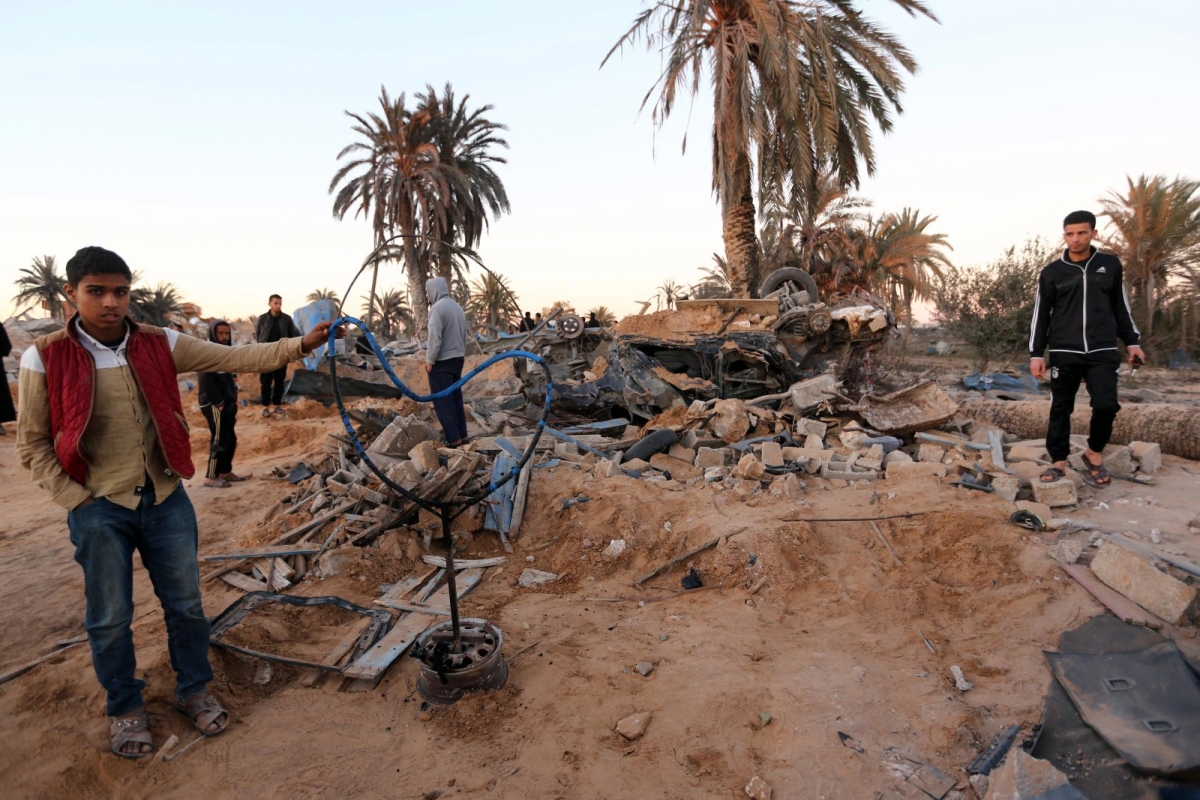 |
| Rev. Chris Antal and a quilt commemorating the victims of U.S. drone attacks. Image source: DronesQuiltProject.com |
What is this "permanent military supremacy and global power projection" so celebrated at the recent Democratic Party convention? Most in the U.S. would be hard pressed to describe it beyond a vague notion that we are at war with terror, and ISIS is its latest face.
Today I offer an overview of the many, many wars the U.S. is engaged in while attention focuses on the circus of electing the next actor who will explain to us what our corporate overlords have decided to do.
 |
| Aftermath of U.S. bombing of Sabratha, Libya. Image source: d.ibtimes.co.uk |
We're bombing Libya this week, the nation whose leader was toppled in an event described gleefully by a corporate party candidate as, "We came, we saw, he died." Now widely considered a failed state with no effective national government five years on, some also consider it the launching pad for AFRICOM's projection of force over that rich continent. The president explained to reporters that we are bombing Libya to "finish the job" of driving out terrorists. This despite the fact that bombing civilians very often leads to the young men of a targeted area signing up to resist U.S. aggression.
Analysts, including those embedded in the U.S. power structure itself, often remind us that "There is no military solution in ____." But the Pentagon and Wall St. aren't looking for solutions, just profits.
| Image source: SyrianRefugees.eu |
The bloodbath and refugee crisis of staggering proportions continue, with U.S. officials ordering air strikes and sending in troops while demagogues denounce the refugees as dangerous in order refuse them entry. Even the president acknowledges that "there is no military solution in Syria" but the Pentagon keeps bombing Syria anyway. Invading Syria was part of the neocon game plan back in 2003 when the U.S. invaded neighboring Iraq; things didn't go as swiftly as the Pentagon had planned, and it has taken more than a decade to ramp up the destabilizing violence in this key petroleum corridor.
 |
| Image source: pbs.org "Marines say latest fight for Fallujah reignites anguish over Iraq War" |
The president has announced several times that he ended combat in this inherited warfront, adding to the pile of lies he was hired to tell. There seem to be around 5,000 troops there currently. This summer saw the third big battle to control the key city of Fallujah, a military action ironically code named "Operation Breaking Terrorism." A U.S. soldier who died in Iraq in 2004 became an unwitting political football in the election circus as his parents allowed themselves to be used by one of the corporate parties earning the disdain of the demagogue with the bad hair, ostensible candidate for the other corporate party.
| Image source: Global Research "Troops are protecting Afghan opium as U.S. occupation leads to all time high heroin production" |
Who weeps for Afghanistan, the country targeted after the inside job of 9/11 ushered in the endless war on terror? After 14 years of U.S. led war, conditions are as bad for Afghans as they have ever been: Kabul's infrastructure is in ruins and the Taliban continue to regain control of key areas. Drones rain down bombs on civilians while U.S. casualties continue. Perhaps if people in the U.S. better understood the connection between U.S. support for the warlords who fund their operations via opium production and the heroin crisis here at home they would insist that the U.S. military leave Afghanistan.
| Image source: Voice of America "Pakistani local residents gather around a burning vehicle hit by a U.S. drone strike, May 21, 2016. Afghan Taliban Mullah Akhtar Mansoor was the target of the drone near Dalbandin, Baluchistan, Pakistan." |
Supposedly a U.S. ally, Pakistan's government cannot stop the CIA and/or Pentagon from drone bombing their border areas with Afghanistan.
| Image source: CNN.com |
Last year Western journalists in Somalia reported that being on the receiving end of U.S. drone strikes was considered an honor by terrorist group Al Shabaab. Not so much by the civilians who die in the bombings.
Could most in the U.S. find Somalia on a map? Doubtful.
| Image source: todayonline.com "A man and a boy walk at a site hit by a Saudi-led air strike in Yemen's capital. Photo: Reuters" |
"Obama disastrously backed Saudi Arabia in Yemen, now he's deploying U.S. troops to deal with the fallout: the U.S. says it is fighting the same Al Qaeda affiliates that are allied with elements of the coalition America is backing" by Sarah Lazare on May 12 pretty much says it all. These are not wars that are meant to be won. Here's her full article on Alternet.
I grow weary, as I suspect you do, too, if you've continued reading to this point. Perhaps tomorrow I will continue my inventory of U.S. military presence in far flung spots around the planet. Next up: South Korea, Ukraine, Okinawa, Lithuania, Poland, etc.
Just because it's invisible to most in the U.S. doesn't mean WWIII isn't rolling onward to oblivion. When the blowback reaches our shores, a hard rain is gonna fall.
No comments:
Post a Comment
Because of a deluge of spam, I have had to switch to moderated comments. Sorry for the inconvenience.